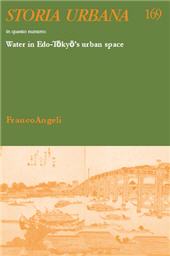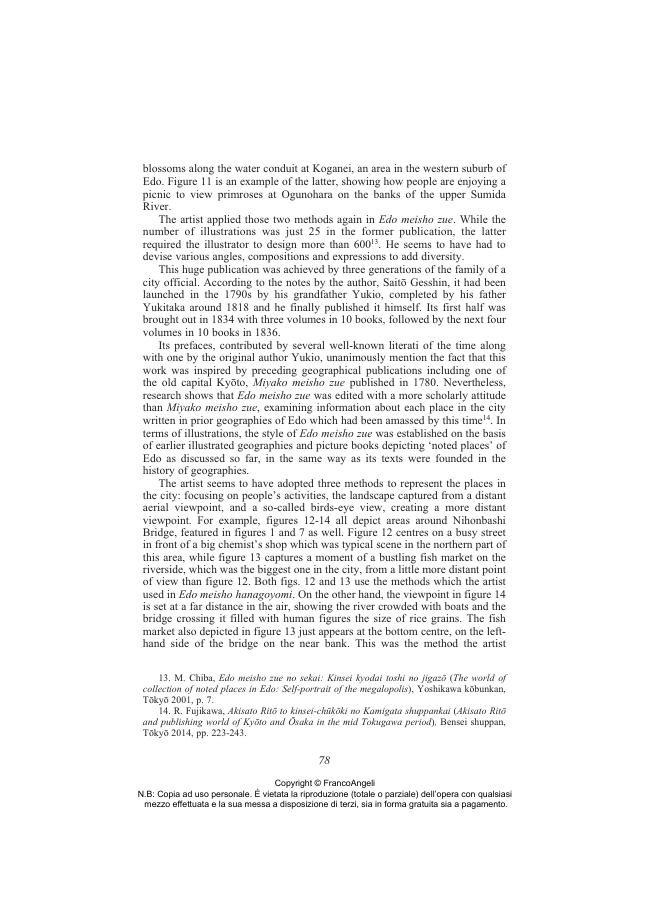Representations of Edo-Tōkyō in Illustrations
65-91 p.
This paper follows the process of development of visual representations of Edo in publications from its origins in the XVII century to the XIX century when the city began modernization. They primarily took the forms of illustrations of guidebooks or geographies depicting'noted places' such as temples and shrines. Due to the prosperity of the city and the development of its own culture, they opened up a new avenue of picture books of'noted places' illustrated by ukiyoe artists who played important roles in fostering the unique culture of the city. The idea of'noted places' was expanded to include the locations where its citizens enjoyed seasonal outings through those picture books. These pictures often focused on human figures at these places as their backgrounds, while landscape expression with perspective introduced from the West was also developed in these picture books.
In the process of evolution of illustrated works of the city, depictions of people enjoying their lives was continuously essential. The fact is convincing when we take into consideration that representations of cities in the history of East Asian paintings often reflected not only their realities but also the desires of those involved in producing them. The presence of people who led pleasant lives there was necessary to complete the image of the ideal cities. Representations of EdoTōkyō also sought to keep images of its state in older times within them in various ways. It would appear to be a method of preserving the memory of the city which was repeatedly destroyed by fires and earthquakes and continuously changing its appearance. [Publisher's text].
Questo articolo analizza il processo di sviluppo delle rappresentazioni visive di Edo nelle pubblicazioni dalle sue origini nel XVII secolo al XIX secolo, quando la città si avviò verso un processo di modernizzazione. Tali rappresentazioni presero principalmente la forma di illustrazioni per guide che raffiguravano "luoghi famosi"(meisho), come templi e santuari. A seguito della crescita economica e demografica e dello sviluppo culturale di Edo, esse aprirono la strada a libri illustrati, con raffiguraÂÂ zioni di "luoghi noti" di artisti ukiyoe impegnati nel promuovere la cultura unica della città. Questa idea di "luoghi noti" fu ampliata per includere le aree utilizzate dai suoi abitanti per le loro gite stagionali. Le immagini di questi libri illustrati spesso si conÂÂ centravano sulle figure umane che godevano della bellezza di questi luoghi, i quali fungevano piuttosto da sfondo, mentre si sviluppava la rappresentazione del paesaggio secondo la prospettiva introdotta dall'Occidente.
La presenza di soggetti umani raffiÂÂ gurati in momenti di svago e di divertimento fu essenziale nel processo di evoluzione delle opere illustrate della città, ed è un tratto comune nelle rappresentazioni delle città nella storia dei dipinti dell'Asia Orientale, le quali riflettevano non solo la realtà, ma anche i desideri di coloro che erano coinvolti nella loro produzione. In tal senso, la presenza di persone che vi conducevano una vita piacevole era necessaria per compleÂÂtare l'immagine delle città ideali. Nelle rappresentazioni di EdoÂÂTōkyō, inoltre, si cercò in vari modi di mantenere le immagini di come appariva in tempi più antichi, come a voler conservare la memoria di una città più volte distrutta da incendi e terreÂÂ moti e che mutò continuamente il suo aspetto. [Testo dell'editore].
Fait partie de
Storia urbana : rivista di studi sulle trasformazioni della città e del territorio in età moderna : 169, 2, 2021-
Articles du même numéro (disponibles individuellement)
-
Informations
Code DOI : 10.3280/SU2021-169003
ISSN: 1972-5523
KEYWORDS
- EdoÂÂTōkyō Illustrazioni Guide Luoghi famosi (meisho) Artisti ukiyoe
- EdoTōkyō, illustrations, guidebooks, noted places, ukiyoe artists



